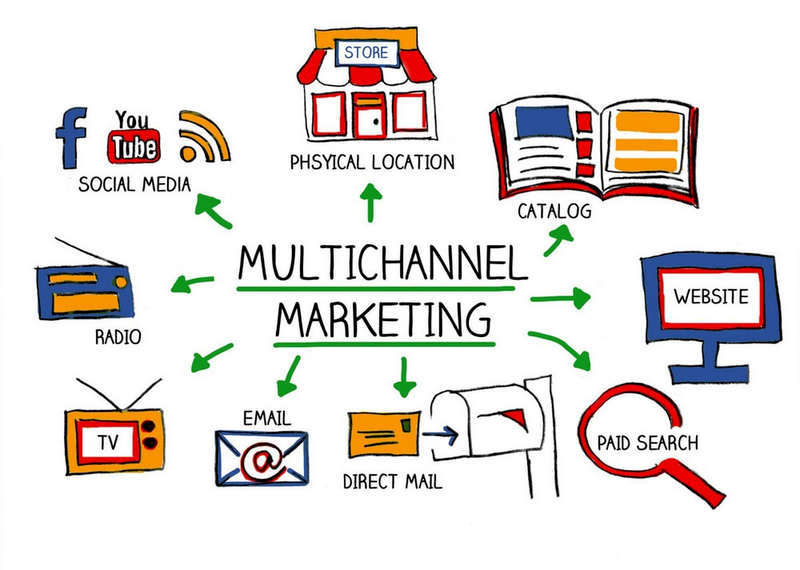Multichannel marketing and MarTech

Multichannel marketing is the practice whereby companies engage with customers through multiple channels, directly and indirectly, to sell goods and services. Companies use direct channels, those through which the company proactively reaches the customer -- such as stores, catalogues and direct mail -- or indirect channels, through which content is distributed via websites or social media, also known as inbound marketing.
What is multichannel marketing?
Multichannel marketing is the practice whereby companies engage with customers through multiple channels, directly and indirectly, to sell goods and services. Companies use direct channels, those through which the company proactively reaches the customer -- such as stores, catalogues and direct mail -- or indirect channels, through which content is distributed via websites or social media, also known as inbound marketing.
With multichannel marketing, other means of reaching customers include mobile devices, SMS, email, company websites, social media, search engine optimization or GPS to track how close customers are to goods and services. Multichannel marketing combines inbound and outbound marketing practices with the goal of reaching customers through the channel of their choice. In this way the buying process is driven by the customer rather than the marketer.
Multi-channel marketing is based on the fact that customers have more choices than ever before in terms of how to find out about products. The proliferation of available channels, including email, social media and mobile phones, has led marketing departments to increase their presence on these channels to improve their customer relationship management (CRM) efforts.
Old methods of marketing, such as the use of print sources, telemarketing and radio and television broadcasting, are no longer the sole responsibility of marketing departments. These methods are still present, but they are part of a larger strategy that includes new media. Marketing strategies evolve with changing consumer tastes and communication preferences.
How to build a successful multi-channel marketing strategy?
Multichannel strategies are long-term plans designed to build brand awareness and maintain relationships with prospective and existing customers. The following steps will ensure a successful multichannel strategy:
Develop analytics. Organizations should use customer data platforms to collect and analyse customer data from multiple sources. Analytics allows companies to use customer behaviour and demographics to determine which customers should receive which marketing messages. Developing a personalised marketing strategy increases the likelihood of customer engagement and a good customer experience.
Understand channel preferences. The best approach is to seek to understand which channels customers prefer. This allows companies to target the right audience with the right content.
Be consistent across channels. Businesses should develop marketing and other digital marketing campaigns that span multiple channels. Expecting customers to adapt to a company's preferred channel is unrealistic. Companies need to align their online and offline channels. For example, testing online marketing keywords can inform the effectiveness of certain campaigns before they become print ads or other advertising. Aligning in-store experiences with digital channels is also a good approach.
Measure attribution. Once a multichannel campaign is complete, the company should evaluate performance. This helps companies know which channels were successful and which had the biggest impact on other channels. Companies can choose from several marketing attribution models to do this. By knowing which channel campaigns have led to the most sales, businesses can determine the effectiveness of their efforts and measure the return on their presence in each channel.
Choose the right platform. The multichannel marketing platform an organisation chooses will help it achieve the above goals. It should provide campaign management capabilities, predictive analytics and marketing attribution analysis.
What are the benefits of multi-channel marketing?
The benefits of multi-channel marketing include:
360-degree view of the customer. Customer feedback helps companies understand what customers expect and how they can improve their product and service offerings. Companies can adjust marketing activities and identify which channels work best for particular customer segments and how to target the needs of each group. A 360-degree view of the customer creates more marketing opportunities and a more personalised experience for customers.
Competitive advantage. A multi-channel approach allows companies to identify gaps in competitors' strategies and focus on channels that others do not.
Better sales management. Companies promote their message through as many channels as possible to gather feedback from different customer segments. Multi-channel marketing encourages the use of crowdsourced information, which can help companies evaluate and improve their performance. This approach ensures efficient use of resources and can reduce operational costs.
Greater visibility and more sales. The more visible a message, the more potential customers a company can attract. Marketing through a single channel reduces the chances of reaching most prospective customers. Companies can use their presence in different channels to create a personalised image, build a customer base and increase retention and loyalty.
Multichannel marketing challenges
Despite the benefits, multi-channel marketing presents many challenges. These include:
Inconsistency. Each channel is unique and has its own requirements for marketing. This can make it difficult to deliver a consistent message across all channels, departments and brands. Some information can be repeated or lost if there are silos of information that isolate channels.
Uncoordinated technology. Different channels may have different technology requirements and different tools. This can make it difficult to coordinate technology across channels and to provide adequate IT staff and support for all channels. For example, one channel may provide primarily qualitative data that may be more difficult to interpret with the same technology used for quantitative data.
Measurement issues. It can be difficult to measure some aspects of the marketing message across multiple channels, such as brand reach, consistency or engagement levels. It can also be difficult to know which channel or customer touchpoint triggered the response.
Channels used in multi-channel marketing
Examples of channels used in a multi-channel campaign include:
Email. This is an older multichannel marketing channel. Marketers can coordinate emails with other channels. For example, they can send a follow-up text message to a customer shortly after they open an email.
Physical storefronts. Depending on the industry, physical store locations can play an important role in customer engagement and satisfaction. They can also determine how other channels approach the customer experience at the physical store.
Push notifications. These often appear on a website or mobile app. Push notifications, for example, are used to offer rewards when someone makes a purchase within a certain timeframe.
SMS messages. Companies can send SMS or text messages to customers advertising offers or updates that they have previously shown interest in through another channel.
Podcasts. Podcasts are similar to traditional radio ads in that they add an audio format to the ad.
Social media. Social media monitoring tools that track opinions about a brand or product can be used to gather customer feedback and integrate it into the CRM platform. Sentiment analysis can also be used to draw insights from customer feedback on social platforms.
Examples of multi-channel marketing
Here are two real-life examples of multichannel marketing.
Vrbo
This is the company's app for short-term holiday rentals. Vrbo has designed its website and app experience to work across multiple devices and meet customers where they are. It distributes user-generated content - such as pictures and reviews of holidays booked through the app - via social media platforms to engage prospective users and increase brand awareness.
Vrbo offers targeted advertising to social media users using information from search queries passed through the platforms. If someone searches for holiday information on one platform, Vrbo can use the insights from that search to serve an ad at a different time. This increases brand reach and improves customer retention, re-engagement and brand loyalty.
CVS
CVS aims to replicate the in-store pharmacy experience through its web and mobile apps. Customers can use the platform to check and fill prescriptions, register for COVID-19 services and manage other shopping needs. The app has an online chat feature that allows customers to speak to a pharmacist. Customers can also receive in-app notifications and text alerts about their prescriptions. By aligning digital channels with the physical customer experience, CVS will increase brand reach, deliver consistent messaging and enhance customer convenience.
Multichannel marketing vs. omnichannel marketing
Here are some key differences between multichannel and omnichannel marketing.
Multichannel marketing
In multichannel marketing, each channel exists in a silo. Some information is limited to that channel and there are boundaries between channels. This creates information silos and inconsistencies between channels. It can force customers to provide or view the same information repeatedly. Customers then get the impression that the organisation has a limited understanding of the customer journey.
Omnichannel marketing
Omnichannel marketing is an evolution of multichannel marketing. It removes barriers between channels and eliminates information silos. It achieves this by carrying information about -- and for -- the customer across channels, so that the same information is available across all channels. As a result, there is greater consistency across channels in the information provided, the branding and the sense of experience.
Omnichannel marketing also reduces duplication between channels. An omnichannel environment preserves customer behavior across channels and along the customer journey. Once a customer starts on a channel, they don't have to repeat steps or see redundant information when they switch channels. All channels have the same understanding of customer behavior and deliver a coordinated, seamless experience. This information sharing also gives organisations a better understanding of customer behaviour and preferences.
